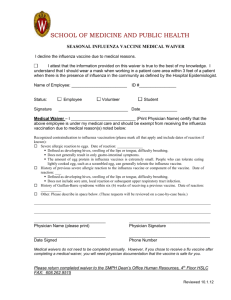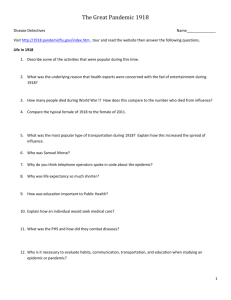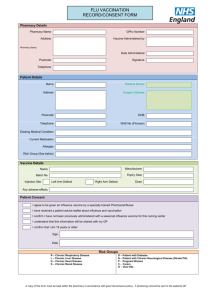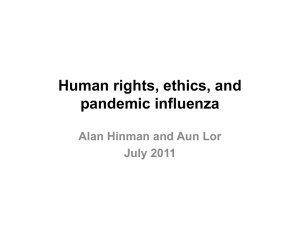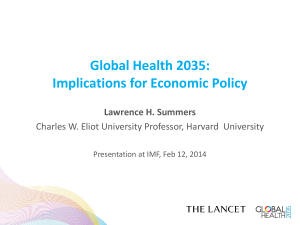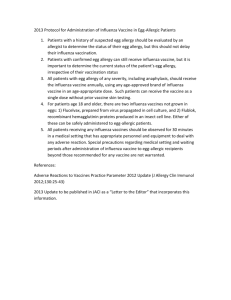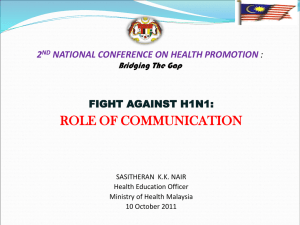Additional File 1
advertisement
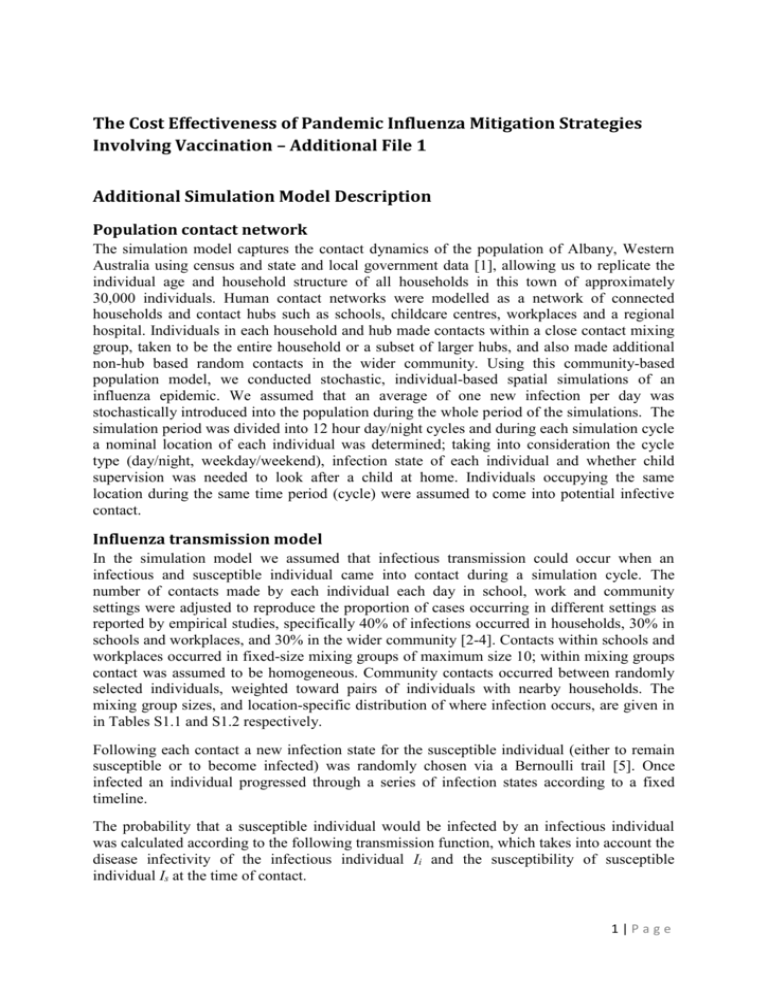
The Cost Effectiveness of Pandemic Influenza Mitigation Strategies Involving Vaccination – Additional File 1 Additional Simulation Model Description Population contact network The simulation model captures the contact dynamics of the population of Albany, Western Australia using census and state and local government data [1], allowing us to replicate the individual age and household structure of all households in this town of approximately 30,000 individuals. Human contact networks were modelled as a network of connected households and contact hubs such as schools, childcare centres, workplaces and a regional hospital. Individuals in each household and hub made contacts within a close contact mixing group, taken to be the entire household or a subset of larger hubs, and also made additional non-hub based random contacts in the wider community. Using this community-based population model, we conducted stochastic, individual-based spatial simulations of an influenza epidemic. We assumed that an average of one new infection per day was stochastically introduced into the population during the whole period of the simulations. The simulation period was divided into 12 hour day/night cycles and during each simulation cycle a nominal location of each individual was determined; taking into consideration the cycle type (day/night, weekday/weekend), infection state of each individual and whether child supervision was needed to look after a child at home. Individuals occupying the same location during the same time period (cycle) were assumed to come into potential infective contact. Influenza transmission model In the simulation model we assumed that infectious transmission could occur when an infectious and susceptible individual came into contact during a simulation cycle. The number of contacts made by each individual each day in school, work and community settings were adjusted to reproduce the proportion of cases occurring in different settings as reported by empirical studies, specifically 40% of infections occurred in households, 30% in schools and workplaces, and 30% in the wider community [2-4]. Contacts within schools and workplaces occurred in fixed-size mixing groups of maximum size 10; within mixing groups contact was assumed to be homogeneous. Community contacts occurred between randomly selected individuals, weighted toward pairs of individuals with nearby households. The mixing group sizes, and location-specific distribution of where infection occurs, are given in in Tables S1.1 and S1.2 respectively. Following each contact a new infection state for the susceptible individual (either to remain susceptible or to become infected) was randomly chosen via a Bernoulli trail [5]. Once infected an individual progressed through a series of infection states according to a fixed timeline. The probability that a susceptible individual would be infected by an infectious individual was calculated according to the following transmission function, which takes into account the disease infectivity of the infectious individual Ii and the susceptibility of susceptible individual Is at the time of contact. 1|Page Ptrans(Ii,Is) = β × Inf(Ii) × Susc(Is) × AVF(Ii,Is) × Vaccine(Is) The transmission probability coefficient β, capturing the infectivity of the virus strain, was chosen to give unmitigated epidemics with a specific effective reproduction number R0, and R0 = 1.5, 1.9 and 2.6 have been used in this study to capture transmission characteristics for mild, moderate and extreme influenza pandemics respectively. The R0 values for the three pandemic scenarios were calculated by fitting an exponential growth curve to the daily incidence in the early stages of the pandemic, using the daily incidence and serial interval distribution recorded from 40 randomly seeded simulations, following the method described in [6]. The disease infectivity parameter Inf(Ii) was set to 1 for symptomatic individuals at the peak period of infection and then to 0.5 for the rest of the infectivity period The infectiousness of asymptomatic individuals is also assumed to be 0.5 and this applies to all infected individuals after the latent period but before onset of symptoms. The infection profile of a symptomatic individual was assumed to last for 6 days as follows: a 0.5 day latent period (with Inf(Ii) set to 0) is followed by 1 day asymptomatic and infectious, where Inf(Ii) is set to 0.5; then 2 days at peak infectiousness (with Inf(Ii) set to 1.0); followed by 2.5 days reduced infectiousness (with Inf(Ii) set to 0.5). For an infected but asymptomatic individual the whole infectious period (of 5.5 days) is at the reduced level of infectiousness with Inf(Ii) set to 0.5. This infectivity profile is a simplification of the infectivity distribution found in a study of viral shedding [7]. As reported below in the results section for the unmitigated no intervention scenario, these assumptions regarding the duration of latent and infectious periods lead to a mean generation time (serial interval) of 2.47 days which is consistent with that estimated for A/H1N1 2009 influenza [8]. Following infection an individual is assumed to be immune to re-infection for the duration of the simulation. We further assume that influenza symptoms develop one day into the infectious period [7], with 20% of infections being asymptomatic among children and 32% being asymptomatic among adults. These percentages were derived by summing the agespecific antibody titres determined in [9]. Symptomatic individuals will withdraw into the home with the following probabilities; adults 50% and children 90%, which is in keeping with the work of [4, 10]. The susceptibility parameter Susc(Is) is a function directly dependent on the age of the susceptible individual. It captures age-varying susceptibility to transmission due to either partial prior immunity or age-related differences in contact behaviour. Age-based susceptibility Susc(Is) was calibrated to reproduce age-specific infection rates observed in the 2009 pandemic [11]. Figure S1.1 gives the age-specific distribution of infections for the three pandemic scenarios. An alternative age-based susceptibility profile, where all age groups were equally susceptible, was used in a sensitivity analysis. The antiviral efficacy factor AVF(Ii,Is) = (1 - AVEi)*(1 - AVEs) represents the potential reduction in infectiousness of an infected individual (denoted by AVEi) induced by antiviral treatment, and the reduction in susceptibility of a susceptible individual (denoted by AVEs) induced by antiviral prophylaxis. When no antiviral intervention was administrated the values of both AVEi and AVEs were assumed to be 0, indicating no reduction in infectiousness or susceptibility. However, when antiviral treatment was being applied to the infectious individual the value of AVEi was set at 0.66, capturing a reduction in infectiousness by factor of 66% [12]. Similarly, when the susceptible individual was undergoing antiviral prophylaxis the value of AVEs was set to 0.85 indicating a reduction in susceptibility by a factor of 85% 2|Page [12]. This estimate is higher than most previous modelling studies, which assume an AVEs of 30% (e.g. [4, 13, 14]). This common assumption appears to stem from an estimate made in [15] based on 1998-1999 trial data. Our higher value is based on a more comprehensive estimation process reported in [12], which also incorporated an data from an additional study performed in 2000-2001 [16]. It is also in line with estimates of 64%-89% reported in [17]. Vaccination model The vaccination parameter Vaccine(Is) represents the potential reduction in susceptibility owing to vaccination, representing some level of immunity. For unvaccinated individuals, or for individuals for whom the vaccine is ineffective, this parameter is 1.0, indicating no reduction in susceptibility. For effectively vaccinated individuals, the parameter value changed from 1.0 to 0.0 according to a schedule described below. Vaccine effectiveness was modelled as follows; after vaccination with the first dose each individual was randomly assumed to have had a successful or failed vaccination. In this study, use of a highly effective vaccine is assumed. Trials of candidate vaccines for the H1N1 2009 pandemic influenza showed seroconversion rates of vaccines (defined as having a fourfold neutralizing seroconversion rate) between 82 and 92 per cent [18]. Vaccines with an efficacy of 75% are therefore assumed. A sensitivity analysis of this assumption is also conducted assuming vaccine efficacy of 65% and 85%. For those where vaccination failed the vaccine has no effect. It was assumed that vaccinated individuals who failed to develop immunity were no less infectious than unvaccinated individuals. It may be the case that vaccinated individuals who subsequently contract influenza experience a less severe infection, which may reduce morbidity and infectiousness. This assumption was not modelled, hence the results are if anything somewhat conservative. For moderate and extreme pandemics, it was assumed the population was immunologically naïve and that complete immunity would not be achieved without two doses of vaccine; whereas for mild pandemics it was assumed that a single does was effective. Moreover, it was assumed complete immunity would only be achieved (for those whom vaccination was successful) after 2 doses of a customised vaccine (high-effectiveness). In the absence of definitive data, the conservative assumption was made that an individual would not develop any humoral immunity in the week immediately following the first vaccine dose. It was further assumed that, in the proportion of the population destined to achieve full immunity, protection from infection would rise in a linear fashion from zero at 1 week to 30% at 3 weeks, after the first vaccine dose. Further details and rationale for this immunity model are given in [19], along with sensitivity analyses on key assumptions. We assumed that full immunity developed 1 week after the second vaccine dose (or after the first does, in the case of mild pandemics) and modelled this immunity rising in a linear fashion from week 3 to week 4 (week 1 to week 2 for mild pandemics). This one week time scale is based on of rapid immune response (seroconversion within 7 days) after doses of booster vaccines [20]. Social Distancing and Antiviral Strategies We examined a range of social distancing and antiviral intervention strategies including school closure, antiviral drugs for treatment and prophylaxis, workplace non-attendance (workforce reduction) and community contact reduction. These interventions were considered in combination with vaccination, and social distancing interventions were considered for 3|Page either sustained periods (that is, until the local epidemic effectively ceased by creating a cohort of vaccine immune individuals) or periods of fixed duration (2 weeks or 8 weeks). Antiviral drug interventions and social distancing interventions were initiated when specific threshold numbers of symptomatic individuals were diagnosed in the community, and this triggered health authorities to mandate the intervention response. This threshold was taken to be 0.1% of the population. It was assumed that 50% of all symptomatic individuals were diagnosed, and that this diagnosis occurred at the time symptoms appeared. For sustained school closure, all schools were closed simultaneously once the intervention trigger threshold was reached. For fixed duration (e.g. 2 weeks or 8 weeks) school closure, schools were closed individually as follows: for a primary school the whole school was closed if 1 or more cases were detected in the school; in a high school only the class members of the affected class were isolated (sent home and isolated at home) if no more than 2 cases were diagnosed in a single class; however if there were more than 2 cases diagnosed in the entire high school the school was closed. Note that these school closure policies were only activated after the community-wide diagnosed case threshold was reached; cases occurring in schools before this time did not result in school closure. This policy of triggering school closure based on epidemic progression avoids premature school closure which can reduce the effectiveness of limited duration school closure [21]. Antiviral drugs used for treatment of symptomatic cases, plus prophylaxis of all household members of a symptomatic case was modelled. It was assumed that 50% of symptomatic individuals would be identified for antiviral treatment and/or prophylaxis, and that treatment and prophylaxis would occur 24 hours after the appearance of symptoms. It was assumed that an individual would receive at most one prophylactic course of antiviral drugs. Further details of antiviral interventions along with sensitivity analyses to key assumptions are given in [22, 23]. Workforce reduction (WR) was modelled by assuming that for each day the intervention was in effect each worker had a 50% probability of staying at home and thus did not make contact with co-workers. Community contact reduction (CCR) was modelled by assuming that on days when the intervention was in effect all individuals made 50% fewer random community contacts. Economic Analysis The economic model translates the age-specific infection profile of each individual in the modelled population, as derived by the Albany simulation model, into the overall pandemic cost burden. This overall cost comprises the following components: costs arising directly from interventions including productivity losses due to social distancing, antiviral costs and vaccination costs (this vaccination cost includes the cost of a vaccine itself, delivery cost of vaccines, and time and travel cost required to obtain vaccines); loss of productivity in the workplace arising from illness; medical costs associated with hospitalisation and GP visits of ill individuals; and productivity losses due to death. Age-specific hospitalisation costs are achieved by multiplying the average cost per day by average length of stay for each age group [24, 25]. Hospitalisation costs, including ICU costs, those involving medical practitioner visits, and antiviral drug (and their administration) costs and vaccination costs are taken from the literature [26-28]. Treatment costs, lengths of stay in hospital (both ICU and non-ICU), and other cost data used in establishing the overall cost of mitigated and unmitigated epidemics in the modelled community. 4|Page Productivity losses due to illness and interventions (e.g. necessary child-care due to school closure and workforce reduction) were obtained using average wages and average work-days lost; the latter being determined from day-to-day outbreak data generated by the simulation model. Assumed average wages are taken from the literature [29, 30]. Indirect production losses due to death were derived using a human capital method, based on the net present value of future earnings for an average age person in each age group. This was calculated by multiplying the age-specific number of deaths due to illness by the average expectancy in years of future earnings of an individual by an average annual income [30]. We assumed a maximum earning period up to age 65. Productivity losses due to death were discounted at 3% annually, which is a standard discount used to express all future income in present values [31]. All costs are reported in 2010 US dollars using consumer price index adjustments [32]. 2010 US dollar values are used to make the results readily convertible to a wide range of developed countries. 5|Page Table S1.1 : Model parameters values and cost data Parameters Pandemic Scenarios Mild pandemic Moderate pandemic Extreme pandemic Average hospital stay (days) Average ICU stay (days) Interpersonal contact parameters School class mixing group size Maximum workplace mixing group size Number of community contacts per person per day Vaccination parameters Vaccine efficacy Vaccination delay Vaccination rate Vaccination coverage Antiviral Efficacy Infectiousness reduction Susceptibility reduction prophylaxis symptom reduction probability Logistic parameters related to AVs Diagnosis delay Diagnosis ratio Maximum antiviral courses given for treatment Maximum antiviral courses given for prophylaxis Social Distancing Intervention Related Parameters School Closure Duration School Closure Trigger Probability of a child withdrawal from school Workforce Reduction Duration Workforce Reduction Trigger Probability of an adult withdrawal from workplace if Workforce Reduction in effect Community Contact Reduction (CCR) Duration CCR trigger CCR withdrawal probability Cost analysis assumptions Average wages (per week) Average school closure cost (per student per day) Average GP visit cost Average hospitalization cost (per day) Average ICU cost (per day) Antiviral cost per course Antiviral dispensing cost per course Antiviral shelf life (years) Mean time between pandemics (years) Vaccine cost per dose Vaccine delivery cost Time and travel cost to obtain a vaccine Discount Rate (annually) Values (sensitivity analysis values) Source R = 1·5, Attack Rate = 14%; CFR = 0·03% R = 1·9, Attack Rate = 33%; CFR = 0·25% R = 2.7, Attack Rate = 44%; CFR = 1.5% 4 7 [8, 33-35] [15, 36-39] [37-43] [44, 45] [44, 45] 10 10 4 [3, 4]* [3, 4]* [3, 4]* 75% (65%, 85%) 6 months (2 months, 4 months) 1% per day (5% per day) 100% (10% - 100%) [46-48] - 66% 85% 50% [12, 17] [12, 17] [12] 24 h 50% 1 course per person for 5 days 1 course per person for 10 days - 2 weeks, 8 weeks and sustained 20-40 community cases 1·0 Sustained 2 weeks after first case 0·5 [21] - 2 weeks, 8 weeks and sustained 2 weeks after first case 0.5 - $836 $19.22 $106.97 $1042 $2084 $24.81 $31.22 5 30.3 $17.93 $10.01 $15.62 3% [30] [29] [28] [28] [27, 28] [28] [28] [49] [28] [28] [28] [31] * Percentages of infections occurring in household, school/workplace, and community settings were used to derive interpersonal contact parameters. 6|Page Table S1.2 : Location specific infection rates Location Households Hubs Community Imported pandemic transmissibility R = 1.5 R = 1.9 R = 2.7 37% 39% 39% 37% 35% 34% 20% 24% 26% 6% 2% 1% The percentage of infections occurring in households, hubs (schools and workplaces), the general community, and those imported from outside the community are given for the nointervention mild, moderate and extreme pandemic scenarios. 7|Page Figure S1.1 : Age-specific infection rates Age Specific Infection Rates 100 90 R = 1.5 Infection Rates(%) 80 R = 1.9 70 R = 2.7 60 50 40 30 20 10 0 (0-5) (6-12) (13-17) (18-24) (25-44) (45-64) (65+) Age Groups The percentage of each age group that became infected (symptomatic and asymptomatic infection) is given for three pandemic scenarios: mild (R = 1.5, blue), moderate (R = 1.9, red) and extreme (R = 2.7, green). 8|Page References 1. 2. 3. 4. 5. 6. 7. 8. 9. 10. 11. 12. 13. 14. 15. 16. 17. 18. Australian Burea of Statistics: Census Data Online [http://abs.gov.au/websitedbs/D3310114.nsf/home/Census+data] Cauchemez S, Carrat F, Viboud C, Valleron A, Boelle P: A Bayesian MCMC approach to study transmission of influenza: application to household longitudinal data. Stat Med 2004, 23(22):3469-3487. Cauchemez S, Valleron A-J, Boe¨lle P-Y, Flahault A, Ferguson NM: Estimating the impact of school closure on influenza transmission from Sentinel data. Nature Letters 2008, 452:750-755. Ferguson NM, Cummings DAT, Fraser C, Cajka JC, Cooley PC, Burke DS: Strategies for mitigating an influenza pandemic. Nature 2006, 442:448-452. Papoulis A: Probability, random variables and stochastic processes, 2nd edn. New York: McGraw-Hill; 1984. Wallinga J, Lipsitch M: How generation intervals shape the relationship between growth rates and reproductive numbers. Proceedings of the Royal Society B: Biological Sciences 2007, 274(1609):599-604. Carrat F, Vergu E, Ferguson NM, Lemaitre M, Cauchemez S, Leach S, Valleron A-J: Time lines of infection and disease in human influenza: a review of volunteer challenge studies. Am J Epidemiol 2008, 167(7):775-785. Fraser C, Christl DA, Cauchemez S, Hanage WP, Van Kerkhove MD, Hollingsworth TD, Griffin J, Baggaley RF, Jenkins HE, Lyons EJ et al: Pandemic potential of a strain of influenza A (H1N1): early findings. Science 2009, 324:1557-1561. Fox JP, Hall CE, Cooney MK, Foy HM: Influenzavirus infections in Seattle families, 1975-1979. Am J Epidemiol 1982, 116(2):212-227. Longini IM, Jr., Nizam A, Xu S, Ungchusak K, Hanshaoworakul W, Cummings DAT, Halloran ME: Containing pandemic influenza at the source. Science 2005, 309:1083-1088. ECDC: ECDC Risk Assessment 2009 influenza A(H1N1) pandemic Version 7. In: ECDC Risk Assessemnt. Stockholm: European Center for Disease Control; 2009. Yang Y, Longini IM, Jr., Halloran ME: Design and evaluation of prophylactic interventions using infectious disease incidence data from close contact groups. Appl Statist 2006, 55:317-330. Germann TC, Kadau K, Longini IM, Jr., Macken CA: Mitigation strategies for pandemic influenza in the United States. PNAS 2006, 103(15):5935-5941. Halloran ME, Ferguson NM, Eubank S, Longini IM, Cummings DAT, Lewis B, Xu S, Fraser C, Vullikanti A, Germann TC: Modeling targeted layered containment of an influenza pandemic in the United States. PNAS 2008, 105(12):4639. Longini I, Halloran M, Nizam A, Yang Y: Containing pandemic influenza with antiviral agents. Am J Epidemiol 2004, 159(7):623-633. Hayden FG, Belshe R, Villanueva C, Lanno R, Hughes C, Small I, Dutkowski R, Ward P, Carr J: Management of influenza in households: a prospective, randomized comparison of oseltamivir treatment with or without postexposure prophylaxis. The Journal of Infectious Diseases 2004, 189(3):440-449. Moscona A: Neuraminidase inhibitors for influenza. N Engl J Med 2005, 353(13):1363-1373. Greenberg ME, Lai MH, Hartel GF, Wichems CH, Gittleson C, Bennet J, Dawson G, Hu W, Leggio C, Washington D: Response to a monovalent 2009 influenza A (H1N1) vaccine. N Engl J Med 2009, 361(25):2405-2413. 9|Page 19. 20. 21. 22. 23. 24. 25. 26. 27. 28. 29. 30. 31. 32. 33. 34. 35. 36. Milne G, Kelso J, Kelly H: Strategies for mitigating an influenza pandemic with pre-pandemic H5N1 vaccines. J R Soc Interface 2010, 7:573-586. Hayden FG, Howard WA, Palkonyay L, Kieny MP: Report of the 5th meeting on the evaluation of pandemic influenza prototype vaccines in clinical trials: World Health Organization, Geneva, Switzerland, 12-13 February 2009. Vaccine 2009, 27(31):4079-4089. Halder N, Kelso J, Milne G: Developing guidelines for school closure interventions to be used during a future influenza pandemic. BMC Infect Dis 2010, 10(1):221. Halder N, Kelso J, Milne G: Analysis of the effectiveness of interventions used during the 2009 H1N1 influenza pandemic. BMC Public Health 2010, 10:168. Kelso JK, Halder N, Milne GJ: The impact of case diagnosis coverage and diagnosis delays on the effectiveness of antiviral strategies in mitigating pandemic influenza A/H1N1 2009. PLoS ONE 2010, 5(11):e13797. Lee VJ, Phua KH, Chen MI, Chow A, Ma S, Goh KT, Leo YS: Economics of neuraminidase inhibitor stockpiling for pandemic influenza, Singapore. Emerg Infect Dis 2006, 12(1):95-102. Lee VJ, Tok MY, Chow VT, Phua KH, Ooi EE, Tambyah PA, Chen MI: Economic analysis of pandemic influenza vaccination strategies in Singapore. PLoS ONE 2009, 4(9):e7108. Baguelin M, Hoek AJV, Jit M, Flasche S, White PJ, Edmunds WJ: Vaccination against pandemic influenza A/H1N1v in England: a real-time economic evaluation. Vaccine 2010, 28(12):2370-2384. Keren R, Zaoutis TE, Saddlemire S, Luan XQ, Coffin SE: Direct medical cost of influenza-related hospitalizations in children. Pediatrics 2006, 118:e1321-e1327. Sander B, Nizam A, Garrison LP, Jr., Postma MJ, Halloran EM, Longini IM, Jr.: Economic evaluation of influenza pandemic mitigation strategies in the United States using a stochastic microsimulation transmission model. Value in Health 2009, 12(2):226-233. Perlroth DJ, Glass RJ, Davey VJ, Cannon D, Garber AM, Owens DK: Health outcomes and costs of community mitigation strategies for an influenza pandemic in the United States. Clin Infect Dis 2009, 50:165-174. U.S. Bureau of Labor Statistics [http://www.bls.gov] World Health Organization: Making choices in health: WHO guide to costeffectiveness analysis. In. Geneva: World Health Organization; 2003. USA Historical Consumer Price Index [http://rateinflation.com/consumer-priceindex/usa-historical-cpi.php] Kelly H, Mercer G, Fielding J, Dowse G, Glass K, Carcione D, Grant KA, Effler PV, Lester RA, Gravenor MB: Pandemic (H1N1) 2009 influenza community transmission was established in one Australian state when the virus was first identified in North America. PLoS ONE 2010, 5(6):e11341. Nishiura H, Chowell G, Safan M, Castillo-Chavez C: Pros and cons of estimating the reproduction number from early epidemic growth rate of influenza A(H1N1) 2009. Theoretical Biology and Medical Modelling 2010, 7(1). Dawood FS, Iuliano AD, Reed C, Meltzer MI, Shay DK, Cheng PY, Bandaranayake D, Breiman RF, Brooks WA, Buchy P: Estimated global mortality associated with the first 12 months of 2009 pandemic influenza A H1N1 virus circulation: a modelling study. Lancet Infect Dis 2012. Vynnycky E, Edmunds W: Analyses of the 1957 (Asian) influenza pandemic in the United Kingdom and the impact of school closures. Epidemiol Infect 2008, 136(2):166-179. 10 | P a g e 37. 38. 39. 40. 41. 42. 43. 44. 45. 46. 47. 48. 49. Viboud C, Tam T, Fleming D, Handel A, Miller MA, Simonsen L: Transmissibility and mortality impact of epidemic and pandemic influenza, with emphasis on the unusually deadly 1951 epidemic. Vaccine 2006, 24(44):6701-6707. Simonsen L, Clarke MJ, Schonberger LB, Arden NH, Cox NJ, Fukuda K: Pandemic versus epidemic influenza mortality: a pattern of changing age distribution. J Infect Dis 1998, 178(1):53-60. Glezen WP: Emerging infections: pandemic influenza. Epidemiol Rev 1996, 18(1):64-76. Gani R, Hughes H, Fleming D, Griffin T, Medlock J, Leach S: Potential impact of antiviral drug use during influenza pandemic. Emerg Infect Dis 2005, 11(9):13551362. Mills CE, Robins JM, Lipsitch M: Transmissibility of 1918 pandemic influenza. Nature 2004, 432:904-906. Mathews JD, McCaw CT, McBryde JMES, McCaw JM: A Biological Model for Influenza Transmission: Pandemic Planning Implications of Asymptomatic Infection and Immunity. PLoS ONE 2007(11):1-6. Frost W: Statistics of influenza morbidity with special reference to certain factors in case incidence and case fatality. Public Heath Report 1920, 35:584-597. ANZIC Influenza Investigators: Critical Care Services and 2009 H1N1 influenza in Australia and New Zealand. N Engl J Med 2009, 361:1925-1934. Newall AT, Wood JG, Oudin N, MacIntyre CR: Cost-effectiveness of pharmaceutical-based pandemic influenza mitigation strategies. Emerg Infect Dis 2010, 16(2):224-230. Song JY, Cheong HJ, Seo YB, Kim IS, Noh JY, Heo JY, Choi WS, Lee J, Kim WJ: Comparison of the Long-Term Immunogenicity of Two Pandemic Influenza A/H1N1 2009 Vaccines, the MF59-Adjuvanted and Unadjuvanted Vaccines, in Adults. Clinical and Vaccine Immunology 2012, 19(5):638-641. Saitoh A, Nagai A, Tenjinbaru K, Li P, Roman F, Kato T: Safety and persistence of immunological response 6 months after intramuscular vaccination with an AS03adjuvanted H1N1 2009 influenza vaccine: An open-label, randomized trial in Japanese children aged 6 months to 17 years. Human Vaccines & Immunotherapeutics 2012, 8(6):10-19. Lopez-Macaas C, Ferat-Osorio E, Tenorio-Calvo A, Isibasi A, Talavera J, ArteagaRuiz O, Arriaga-Pizano L, Hickman SP, Allende M, Lenhard K: Safety and immunogenicity of a virus-like particle pandemic influenza A (H1N1) 2009 vaccine in a blinded, randomized, placebo-controlled trial of adults in Mexico. Vaccine 2011, 29(44):7826-7834. Reddy D: Responding to pandemic (H1N1) 2009 influenza: the role of oseltamivir. J Antimicrob Chemother 2010, 65 Suppl 2:ii35-40. 11 | P a g e

